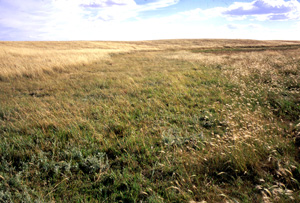Community Field Guide
Scientific Name:
Eleocharis palustris Herbaceous Vegetation
Common Name:
Common spikerush Wet Meadow
Community Description
Summary:
This spikerush wet meadow community is found in the central Great Plains of the United States and Canada and in the western United States. Stands occur in small depressions in intermittent streambeds or depression ponds that flood early in the season and may dry out by summer. Stands are composed of submersed and emergent rooted vegetation under 1 m tall that is dominated by Eleocharis palustris, often in nearly pure stands. Soils are generally fine-textured.
Environment:
The Eleocharis palustris community type is found at low to moderate elevations, generally in wide, low gradient valleys of all shapes. Sites are wet basins, floodplains, meadows, gravel bars, and lake edges. It is typically in sites that are prone to yearly flooding or persistent surface water. Where streams are present, they are Rosgen's C and E stream types. Elevations range from 2,200 to at least 8,700 feet, depending on latitude (Hansen et al. 1995; Manning and Padgett 1995; Crowe and Clausnitzer 1997; Hall and Hansen 1997). Soils of this community type are classified as Mollisols, Entisols, Histisols, and Inseptisols. Textures are variable, ranging from sites that are very coarse-fragment rich to others that are deep and fine-textured. The surface is usually rich in organic matter and the litter accumulation may blend into rich, black organic muck soils. The fine-textured upper horizons often arise from alluvial deposition. Sands, gravel, and cobbles usually constitute the main body of deeper subsurface materials (Manning and Padgett 1995; Crowe and Clausnitzer 1997; Hall and Hansen 1997).
Vegetation: >In Montana, Eleocharis palustris is an aggressive, rhizomatous species that nearly excludes all other species from establishing any significant cover. Common associates in high quality sites include Alopecurus aequalis, Mentha arvense, Rumex crispus, Eleocharis acicularis, Carex utriculata, Glyceria ssp., and Phalaris arundinacea. On some sites aquatic species such as Hippuris vulgaris, Utriculata vulgaris, and Potamogeton natans, have high cover.
This wetland association is dominated by submersed and emergent rooted vegetation under 1 m tall and occurs across the northwestern Great Plains and western U.S. within a wide elevational range. The species composition can be quite variable, but this community is easy to recognized by the bright green, nearly pure stands of Eleocharis palustris. Vegetation cover can be sparse to dense (10-90%), but Eleocharis palustris is the dominant species, and the only species with 100% constancy. Other species, when present, can contribute as much as 40% cover, but never exceed that of the Eleocharis palustris cover. Some of this variation is described from Colorado (Kittel et al. 1999, Baker and Kennedy 1985). Co-occurring species in low-elevation stands on the western slope can include Phalaris arundinacea (= Phalaroides arundinacea), Juncus balticus, Hordeum jubatum, Pascopyrum smithii, Schoenoplectus americanus (= Scirpus americanus), Sparganium angustifolium, species of Lemna and Potamogeton, as well as the introduced Melilotus officinalis and Bromus inermis. <
Range:
Eleocharis palustris is a common type in California, Colorado, Idaho, Montana, Nevada, Oregon, Utah, Washington, Wyoming, and Saskatchewan. Essentially it has been documented from every western state except Arizona and New Mexico (Bourgeron and Engelking 1994; Anderson et al. 1998).
Dynamics:
The hydrological regime is critically important to this association. Most stands are seasonally to permanently flooded, although some in the Great Plains occur under intermittently to temporarily flooded conditions. ^Baker and Kennedy (1985) suggest that domestic livestock grazing may tend to result in increases in Hordeum jubatum, Bassia scoparia, and Polygonum aviculare. However, Hansen et al. (1988a) suggest that palatability of Eleocharis palustris is low for both domestic and wild animals, but that heavy grazing may increase this rhizomatous species and spread it onto adjacent sites. Trampling damage may occur to this type when animals heavily use the sites supporting it, particularly during drought years (Hansen et al. 1988a). Water level fluctuations over a year of greater than 1 m will not support this type (Hansen et al. 1988a).
Management:
Seasonally wet conditions and low palatability of Eleocharis palustris limit the grazing value of this type for livestock, even during drought years when upland forage dries early and dies back (Kovalchik 1987). Sites occupied by this type are typically inundated or at least saturated for much of the year so as to preclude most development. Trampling damage and soil churning occurs readily with livestock use and may result in a shift toward more disturbance tolerant species such as Hordeum jubatum, Carex nebrascensis, and Juncus balticus (Hall and Hansen 1997).
Global Rank: G5 State Rank: S5
Community References
Identifier:
CEGL001833
Author:
D. Faber-Langendoen, mod. K. Schulz, mod. M.S. Reid, mod. B. Moseley
Citations:
Baker 1983c, Baker and Kennedy 1985, Billings 1945, Bourgeron and Engelking 1994, Brotherson and Barnes 1984, Bunin 1985, Driscoll et al. 1984, Ellis et al. 1979, Flowers 1962, Hall and Hansen 1997, Hansen et al. 1988a, Hansen et al. 1988b, Hansen et al. 1991, Hansen et al. 1995, Kettler and McMullen 1996, Kittel and Lederer 1993, Kittel et al. 1994, Kittel et al. 1999, Kovalchik 1987, Kovalchik 1993, Mutel 1973, Mutel and Marr 1973, Padgett et al. 1988b, Padgett et al. 1989, Penfound 1953, Ramaley 1919a, Ramaley 1942, Stearns-Roger Inc. 1978, Steinauer and Rolfsmeier 2000, Stewart 1940, Von Loh 2000, Youngblood et al. 1985a
View Detailed Citation Information | New Community Search | NatureServe Explorer Community Information
This information is from the:
Montana Natural Heritage Program
Montana State Library--Natural Resource Information System
1515 East Sixth Ave., Helena, MT 59620-1800
406 444-3989
mtnhp.org
mtnhp@mt.gov






